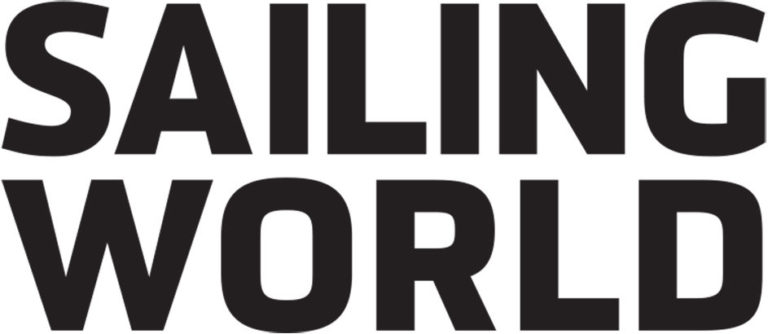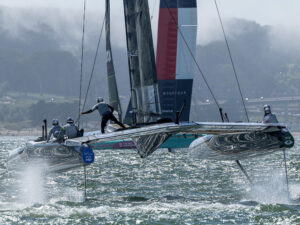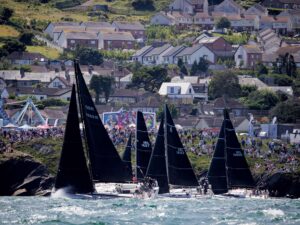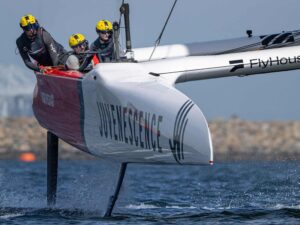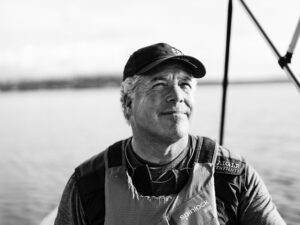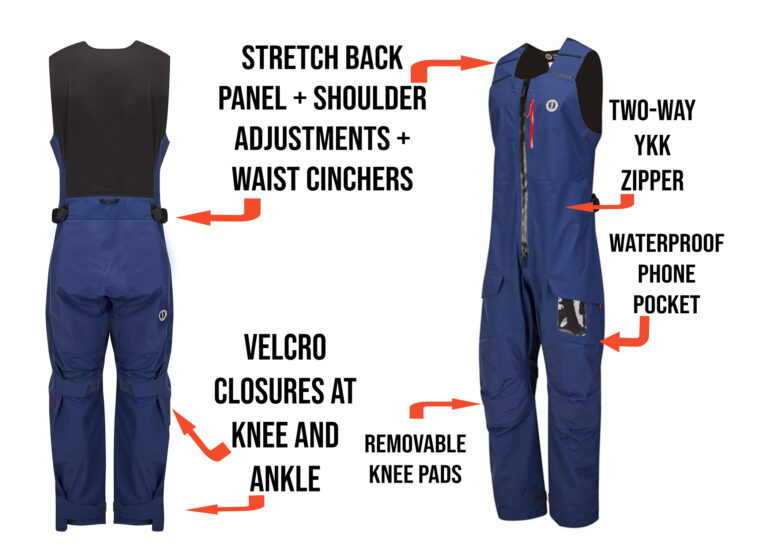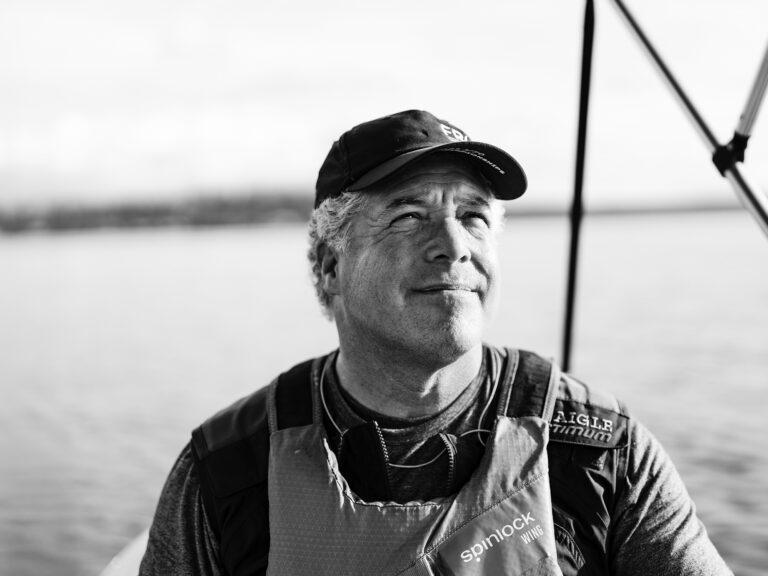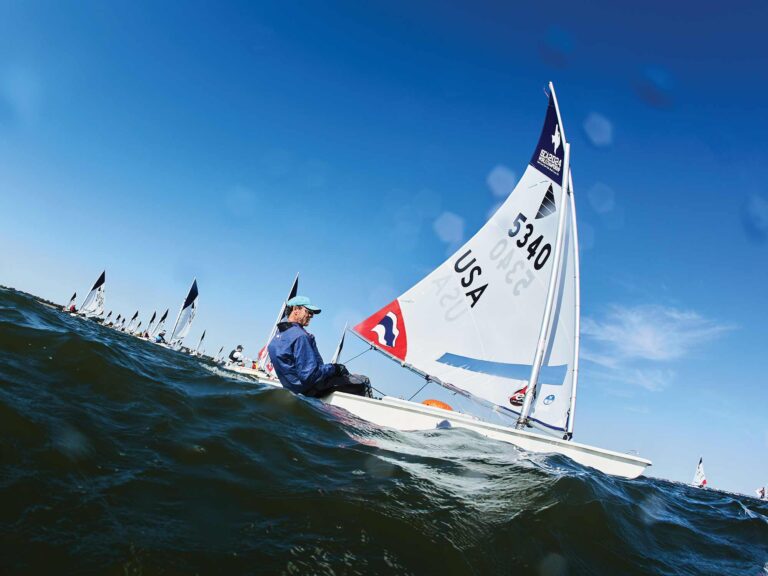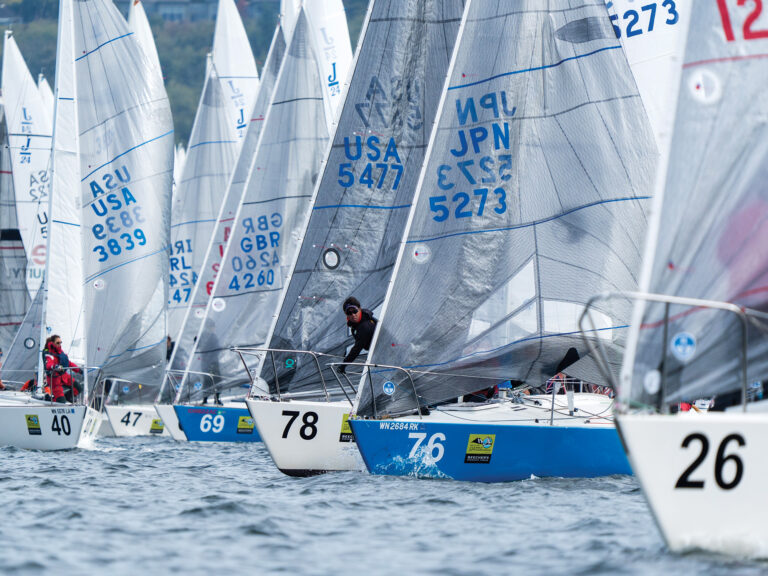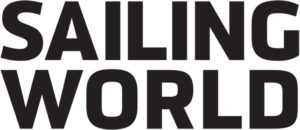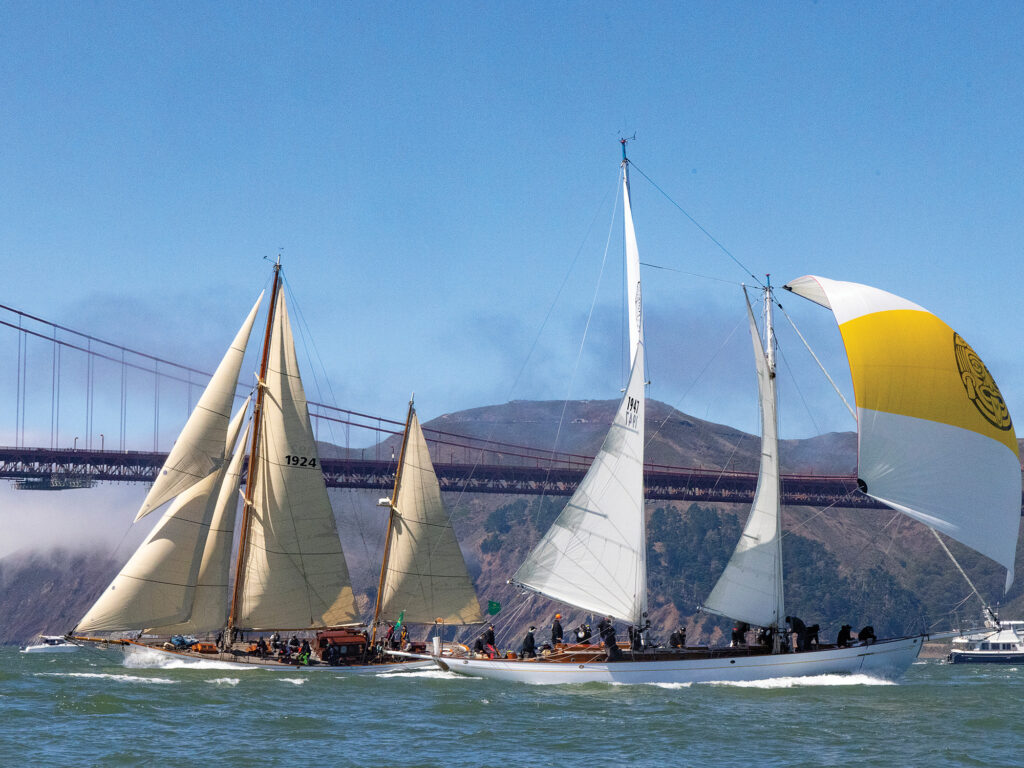
The warning gun fires, and the prestart dance begins in the Classics fleet at the Rolex Big Boat Series hosted by San Francisco’s St. Francis YC. We’ve got 19 knots of wind already, and it’s still early. It will blow. I can feel the building sea breeze that has whipped San Francisco Bay into frenzied whitecaps nearly every summer day for as long as I can remember. For this regatta, I’m not in my usual position as navigator. Today, I’m the tactician. That’s because Mayan is special, and I find that it gives me insight into the expectations of the great tacticians I normally sail with on other grand-prix programs.
“Time to burn to the boat?” I ask Lance Berc, a retired Silicon Valley technologist with an Albert Einstein hairstyle. Berc is holding the “box,” which is the affectionate term for the tablet, repeating the nav computer down below.
“Burning 4 min 25 boat,” comes the answer instantly, just as I’d trained him.
“Pin burn?”
“Burning 4 min pin,” he responds.
His numbers track because I know this patch of water in front of the club like my backyard. Even though the gun has just gone off, I prompt Lance to start giving me a data stream of info to paint the picture like other great tacticians have always encouraged me to do when roles are reversed.
“Beau, tack to follow Hurrica,” I say. Beau Vrolyk is the skipper, driver and chief caretaker, aka owner of Mayan. His wife, Stacy, is handling the runners. We smoothly pull off a tack.
“Lewwy, they are jibing,” Hall of Famer Bill Lee says. “Think they want to play with us.”
Lee, well-known as the “Wizard,” is the designer of the Santa Cruz line of race yachts and the legendary Transpac maxi Merlin, which is also racing in this year’s Big Boat Series.
He’s right about Hurrica V, which jibes in behind us.
“Bearing away to a jibe,” I call, and then quickly follow with, “Burn Pin?”
“Burning 3 min pin,” Berc responds as Hurrica and Mayan complete their first circle.
“Lewwy, are we doing this?” Vrolyk asks.
“Yeah, Beau, we’re doing this—12-Metre America’s Cup style.”
Vrolyk laughs heartily, and with a glance in his direction, I realize that I’ve never seen him so happy.
Mayan and Hurrica are now engaged, dancing in majestic circles. After completing our second circle, I ask, “Boatlength below line, burn pin?”
“Three boatlengths, burning 1 min 20 pin,” Berc says as I also hear the countdown to the gun from Paul Heineken.
“Beau, one more circle,” I say, sensing that nothing would make him happier.
As we complete our third loop, Hurrica is directly in front of us, aimed at the popular Grille Room of St. Francis. I can see the spectators cheering from the club deck.
I ask the same question for tactical info.
“Two boatlengths, burning 30 pin.”
“We’ve got them; we are in the push position,” I say. “They can’t tack and bear away because we’d have them on starboard. Their only choice is to be over the line, especially with the ebb.”
We hold firm until Hurrica is over early.
“Holding…Beau, mow the lawn,” I shout. He understands the lingo and instantly bears away to kill time on starboard.
With 20 seconds remaining to the gun and no more time to burn, I call for a tack onto port, seeing that we will have no traffic issues after the start. We cross the line on port tack close to the shallow pin end—not quite at full speed, but we’ll take it.
Vrolyk had wanted a port-tack start to save the time of a tack after the start to get out into the ebb in the center of the bay because it is strategically smart, never mind the risk. Normally, it’s the tactician who wants to port tack the fleet for glory and strategic advantage, while the owner typically focuses on the bills from a collision. But not on Mayan. Vrolyk is as competitive as sailors get after a lifetime of racing sailboats.
So, port tack they want; port tack they get. We are just lucky that Hank Easom’s Yucca isn’t on the start line this year. He’d never let us get away with such a move, given how much more maneuverable his 8-Metre classic is than this schooner.
The gun sounds, and Mayan is heading out with pace to the good water that is out in the middle of the bay. We know the flow, knowledge gleaned from a lifetime of experience, bog standard tide books, and the high-resolution current models that are piped into our Expedition navigation software.
The crew lets out a cheer as we win the start, and caught up in the excitement, I run forward toward the bow, which definitely surprises the bow team. I high-five all 25 people on board, including my two teenage daughters, Veronica and Verity.
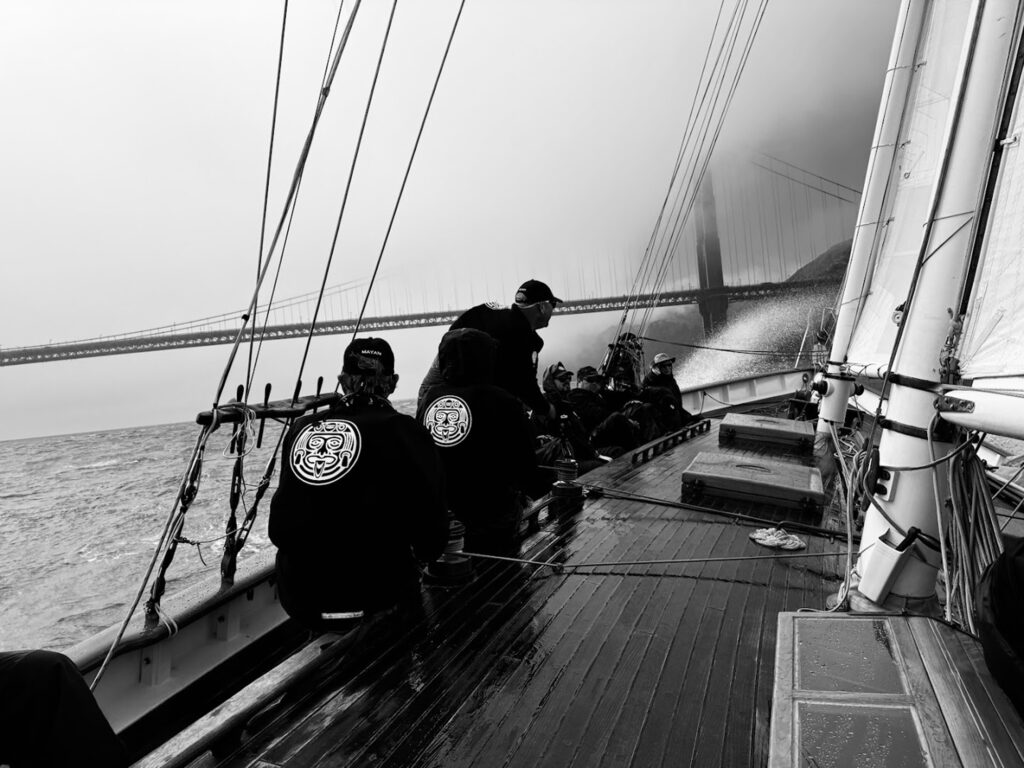
Jogging down the side deck, from bow to stern, the final high-five is reserved for Vrolyk, who yells over the sounds of the shrieking wind: “Good thing we added Casey Gray to grind this year. With all those circles, the mainsheet has never, ever gone in and out that much.”
Given the prestart jargon aboard Mayan on this day, you’d be forgiven to think that we are on an all-carbon TP52 rather than a stately 68,000-pound Alden Schooner built in 1947 in British Honduras. Mayan is the perfect marriage of vintage and modern technology. We’ve spent years refining the polars on Mayan, trying to get the box to give us reasonably accurate numbers. This year we spent extra effort on getting some of the advanced start models correct, which included dialing in the acceleration, rate of turn, and braking files.
You might accuse me of being crazy, but the America’s Cup has given us some “inspo,” as the cool kids say. Watching the AC75s made me realize that they have a lot more in common with an old classic than one might think. Neither boat can accelerate quickly from a stop, and once rumbling, it is difficult to slow them. Even if you blow Mayan’s sheets, the boat’s speed doesn’t change, because of its mass and momentum. And lastly, we really, really don’t want any of these classic monsters to have a collision.
One America’s Cup-inspired start technique to burn time is not to go slower, but rather travel more distance. We named this tactic “mowing the lawn,” which is when we turn away from the line and sail deep downwind for a short distance, then turn back up—not even changing the sail trim as we are just killing time.
As soon as both Mayan and Hurrica V are berthed at St. Francis YC’s docks, a spontaneous and touching standing ovation takes place as the crews honor each other for the start-line fireworks. Later that same evening at one of the club’s parties, we spot Hurrica’s skipper, Mark Sanders, and his crew. Almost immediately, St Francis’ Vice Commodore Adam Gambel (who was the lucky Hurrica helmsperson for the day) runs over to us, full of smiles and enthusiasm, and says, “Those three circles at the start were the most fun and best racing we’ve ever done.”
To that, we all agree.
After a few drinks flow, the commodore leans in, and with a hushed voice, conspiratorially shares, “I want to let you in on Hurrica’s strategy,” he says. The competitor in me is all ears. “We’ve obviously had quite a rivalry with Mayan over the years, and it’s fair to say that you’d definitely gotten the better of us. This year, we decided it is going to be different. On Day 1 of the Rolex Big Boat Series, our goal was: We are coming to your neighborhood. We accomplished that; the racing was tight.”
On Day 2, he says, the strategy was, “we want to play in your backyard, and we did that too. So, this morning, we were a little more aggressive and decided our strategy was: We are getting into your hot tub!”
Gambel roars with laughter and says, “That’s why we wanted to engage in all those circles with you. We were in your hot tub.” I laughed along with him, enjoying the camaraderie and sportsmanship that goes part and parcel with Corinthian classic sailing.
I later realize that we still have one day of racing remaining. Noticing the obvious trend in Hurrica’s strategy, I wonder, If it’s hot tub already, what could possibly be in store for the final day of racing?
Pins drop as we listen for the intel.
“Tomorrow, we’ll be in your single shower stall!” Gambel blurts out, and the crews of both yachts erupted with laughter, one unintentionally spitting out their drink. Moments like this is why I love the Rolex Big Boat Series and St. Francis, which is, of course, one of the oldest and most prestigious yacht clubs in the US. It’s known for its luxurious facilities, world-class sailing programs, and exclusive events, but under the guidance of race chair and Rear Commodore Susan Ruhne and Commodore Chris Perkins, the club sure knows how to host racing events and parties.
Before I get too far ahead of myself, let’s get back to racing. First of all, there’s Mayan. Wherever the famous schooner goes, folks show up at the dock to see the sailboat once owned by musician David Crosby, of Crosby, Stills and Nash fame. Closing your eyes, you can imagine Crosby in his happy place, strumming a guitar, lost in a melody, with the wind carrying his voice across the water. His expression might be a mix of contemplation and contentment, reflecting on a life intertwined with music, creativity, and a deep connection to nature. It’s been said that “Wooden Ships” was written on board Mayan .
During the Crosby era, Mayan hosted the rock star’s parties for decades and would have witnessed countless wild nights. The boat, like its former owner, would have lived life to the fullest, its stately elegance witnessing lives filled with music, laughter, and unforgettable moments such as possibly planning to use Mayan as a getaway boat to avoid extradition. If only the timber could talk.
According to Mayan lore, Crosby was once asked by a curious offshore sailor, “Why doesn’t Mayan have a lee cloth on the main bed?”
To which Crosby, with his signature mustache and long, flowing hair, responded with an innocent smile, “Well, when you sleep on Mayan and have a woman on each side of you, I found that I haven’t needed lee cloths because I can’t roll off the bunk!”
Fast-forward to the modern era of Mayan. She is now cared for by the Vrolyk family. They are not rock stars, but they do share Crosby’s affection for the schooner. They have restored Mayan back to its original glory and to the timeless beauty.
Vrolyk regularly geeks out talking about Mayan’s sleek lines and graceful curves, sculpted by the hands of master craftsmen, which speak of a bygone era of maritime excellence. He and Stacy are also primarily responsible for assembling the diverse, talented crew of Mayan, which also represents a more modern mentality.
For this edition of the Rolex Big Boat Series, the age span of the crew is 8 (Zephyr Gray) to the legendary 82-year-old wizard Lee. The Vrolyks view Mayan as a platform to give folks from all walks of life a chance to have a taste of adventure at sea and perform in a high-performing team.
“If we didn’t work so hard on recruiting young folks on the boat, Mayan would be left with a bunch of old white guys, and Mayan wouldn’t win as much,” Beau says.
Under the watchful eyes of master rigger Mathew Coale, Tommy Lewin, Rob Franks and the Vrolyks, they teach things such as windward rail sheeting, weight movement fore-and-aft, dynamic sail trimming in puffs, and having at least one or two people calling puffs and current lines. Synthia Petroka and Liz Kroft are a female duo who have been flawlessly running the bow team for years. It means the world to me that my teenage girls have been given the chance to sail with me on this occasion, alongside the women and men of Mayan.
I’ll be the first to admit that I never thought that racing classics would be so much fun, but I’m sold. I’ve sailed on a few other classics, such as the 183-foot Adela in the America’s Cup Superyacht Regatta and Zemphira at the “Woodstock” of wooden-boat sailing, which is the Eggemoggin Reach in coastal Maine.
Even Lee, who pioneered the phrase “fast is fun,” may have to come up with a corollary, like “majestic is fun.” There is just such a pure feeling in sailing the classics. The warm wooden hulls and towering masts, adorned with billowing sails, capture the power of the wind (with ridiculously named sails: the Gollywobbler, Flounder and Advance) to propel the vessel through the waves with a sense of elegance, freedom and grace.
Stepping aboard one is like entering a time capsule, where rich nautical history and heritage come alive. Polished-brass fittings gleam in the sunlight and evoke a sense of nostalgia, a true testament to the enduring spirit of classic yachting that is a throwback to the 1800s when San Francisco Bay was filled with the fastest wooden boats eager to capitalize on the California Gold Rush. Racing one alongside go-fast moderns and one-designs in big breeze and complex currents, with the Golden Gate Bridge looming in the distance, is an extraordinary experience.
